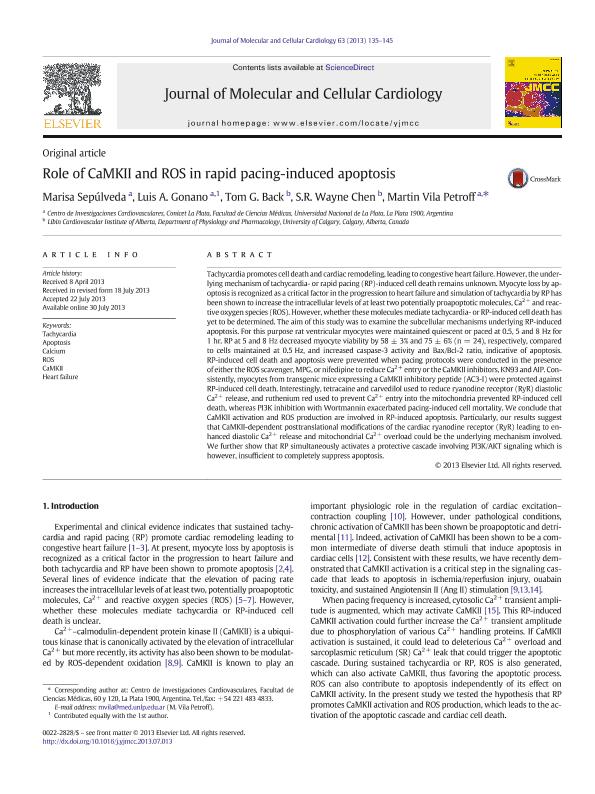Mostrar el registro sencillo del ítem
dc.contributor.author
Sepúlveda, Marisa Noemí

dc.contributor.author
Gonano, Luis Alberto

dc.contributor.author
Back, Tom G.
dc.contributor.author
Chen, S. R. Wayne
dc.contributor.author
Vila Petroff, Martin Gerarde

dc.date.available
2017-01-25T20:25:18Z
dc.date.issued
2013-10
dc.identifier.citation
Sepúlveda, Marisa Noemí; Gonano, Luis Alberto; Back, Tom G.; Chen, S. R. Wayne; Vila Petroff, Martin Gerarde; Role of CaMKII and ROS in rapid pacing-induced apoptosis; Elsevier; Journal Of Molecular And Cellular Cardiology; 63; 10-2013; 135-145
dc.identifier.issn
0022-2828
dc.identifier.uri
http://hdl.handle.net/11336/11944
dc.description.abstract
Tachycardia promotes cell death and cardiac remodeling, leading to congestive heart failure. However, the underlying mechanism of tachycardia- or rapid pacing (RP)-induced cell death remains unknown. Myocyte loss by apoptosis is recognized as a critical factor in the progression to heart failure and simulation of tachycardia by RP has been shown to increase the intracellular levels of at least two potentially proapoptotic molecules, Ca2 + and reactive oxygen species (ROS). However, whether these molecules mediate tachycardia- or RP-induced cell death has yet to be determined. The aim of this study was to examine the subcellular mechanisms underlying RP-induced apoptosis. For this purpose rat ventricular myocytes were maintained quiescent or paced at 0.5, 5 and 8 Hz for 1 hr. RP at 5 and 8 Hz decreased myocyte viability by 58 ± 3% and 75 ± 6% (n = 24), respectively, compared to cells maintained at 0.5 Hz, and increased caspase-3 activity and Bax/Bcl-2 ratio, indicative of apoptosis. RP-induced cell death and apoptosis were prevented when pacing protocols were conducted in the presence of either the ROS scavenger, MPG, or nifedipine to reduce Ca2 + entry or the CaMKII inhibitors, KN93 and AIP. Consistently, myocytes from transgenic mice expressing a CaMKII inhibitory peptide (AC3-I) were protected against RP-induced cell death. Interestingly, tetracaine and carvedilol used to reduce ryanodine receptor (RyR) diastolic Ca2 + release, and ruthenium red used to prevent Ca2 + entry into the mitochondria prevented RP-induced cell death, whereas PI3K inhibition with Wortmannin exacerbated pacing-induced cell mortality. We conclude that CaMKII activation and ROS production are involved in RP-induced apoptosis. Particularly, our results suggest that CaMKII-dependent posttranslational modifications of the cardiac ryanodine receptor (RyR) leading to enhanced diastolic Ca2 + release and mitochondrial Ca2 + overload could be the underlying mechanism involved. We further show that RP simultaneously activates a protective cascade involving PI3K/AKT signaling which is however, insufficient to completely suppress apoptosis.
dc.format
application/pdf
dc.language.iso
eng
dc.publisher
Elsevier

dc.rights
info:eu-repo/semantics/openAccess
dc.rights.uri
https://creativecommons.org/licenses/by-nc-sa/2.5/ar/
dc.subject
Tachycardia
dc.subject
Apoptosis
dc.subject
Calcium
dc.subject
Ros
dc.subject
Camkii
dc.subject
Heart Failure
dc.subject.classification
Sistemas Cardíaco y Cardiovascular

dc.subject.classification
Medicina Clínica

dc.subject.classification
CIENCIAS MÉDICAS Y DE LA SALUD

dc.title
Role of CaMKII and ROS in rapid pacing-induced apoptosis
dc.type
info:eu-repo/semantics/article
dc.type
info:ar-repo/semantics/artículo
dc.type
info:eu-repo/semantics/publishedVersion
dc.date.updated
2017-01-25T13:57:31Z
dc.journal.volume
63
dc.journal.pagination
135-145
dc.journal.pais
Países Bajos

dc.journal.ciudad
Amsterdam
dc.description.fil
Fil: Sepúlveda, Marisa Noemí. Consejo Nacional de Investigaciones Cientificas y Tecnicas. Centro Cientifico Tecnológico la Plata. Centro de Investigaciones Cardiovasculares "dr. Horacio Eugenio Cingolani"; Argentina. Universidad Nacional de la Plata. Facultad de Ciencias Médicas; Argentina
dc.description.fil
Fil: Gonano, Luis Alberto. Consejo Nacional de Investigaciones Cientificas y Tecnicas. Centro Cientifico Tecnológico la Plata. Centro de Investigaciones Cardiovasculares "dr. Horacio Eugenio Cingolani"; Argentina. Universidad Nacional de la Plata. Facultad de Ciencias Médicas; Argentina
dc.description.fil
Fil: Back, Tom G.. University Of Calgary; Canadá
dc.description.fil
Fil: Chen, S. R. Wayne. University Of Calgary; Canadá
dc.description.fil
Fil: Vila Petroff, Martin Gerarde. Consejo Nacional de Investigaciones Cientificas y Tecnicas. Centro Cientifico Tecnológico la Plata. Centro de Investigaciones Cardiovasculares "dr. Horacio Eugenio Cingolani"; Argentina. Universidad Nacional de la Plata. Facultad de Ciencias Médicas; Argentina
dc.journal.title
Journal Of Molecular And Cellular Cardiology

dc.relation.alternativeid
info:eu-repo/semantics/altIdentifier/doi/http://dx.doi.org/10.1016/j.yjmcc.2013.07.013
dc.relation.alternativeid
info:eu-repo/semantics/altIdentifier/url/http://www.sciencedirect.com/science/article/pii/S0022282813002460
Archivos asociados
